Prevalence of antibiotic prescription in pediatric outpatients in Italy: the role of local health districts and primary care physicians in determining variation. A multilevel design for healthcare decision support
- PMID: 29149875
- PMCID: PMC5693576
- DOI: 10.1186/s12889-017-4905-4
Prevalence of antibiotic prescription in pediatric outpatients in Italy: the role of local health districts and primary care physicians in determining variation. A multilevel design for healthcare decision support
Abstract
Background: According to scientific literature, antibacterials are prescribed for common pediatric conditions that do not benefit from antibiotic therapy. The link between antibiotic use and bacterial resistance is well known. Antibiotic overprescribing generates high social costs and severe consequences for children. Our objectives were to analyze antibiotic prescription patterns in pediatric outpatients residing in the Lazio region (Italy), to identify physicians' characteristics associated with increased propensity for prescription, to identify the priority axes for action to improve the rational use of antibiotics.
Methods: We enrolled all children aged 13 years or less in 2014. Antibiotic prescription patterns were analyzed during a one-year follow-up period. The main outcome measures were the antibiotic prescription prevalence, and the geographic variation in antibiotic prescribing. Multilevel models were performed to analyze variation. Variation was expressed as Median Odds Ratios (MORs). If the MOR is 1.00, there is no variation between clusters. If there is considerable between-cluster variation, the MOR will be large.
Results: We enrolled 636,911 children. Most of them were aged 6-13 years (57.3%). In 2015, the antibiotic prescription prevalence was 46% in the 0-13, 58% in the 0-5, and 37% in the 6-13 age group. Overall, penicillins were the most prescribed antibiotics, their consumption increased from 43% to 52% during the 2007-2015 period. In 2015, the antibiotic prescription prevalence ranged from 30% to 62% across local health districts (LHDs) of the region. Moreover, a significant (p < 0.001) variation was observed between physicians working in the same LHD: MORs were equal to 1.52 (1.48-1.56) and 1.46 (1.44-1.48) in the 0-5 and 6-13 age groups, respectively. The probability of prescribing antibiotics was significantly (p < 0.001) lower for more-experienced physicians.
Conclusions: Pediatric antibiotic use in the Lazio region is much higher than in other European countries. The intra-regional drug prescribing variability underlines the lack of therapeutic protocols shared at regional level and raises equity issues in access to optimal care. Both LHD managers and individual physicians should be involved in training interventions to improve the targeted use of antibiotics and mitigate the effect of contextual variables, such as the spatial-related socioeconomic status of the patient/parent binomial.
Keywords: Antibiotic prescription patterns; Geographic variation; Multilevel models; Pediatric outpatients; Preschool children.
Conflict of interest statement
Ethics approval and consent to participate
The ‘Lazio Region Ethics Committee’ formally approved our Study protocol (protocol number: 369/CE). Consent to participate is not required according to Italian regulations. In fact, this is a retrospective, observational, population-based study, which included more than 636,900 people. Data were collected from the health information systems of the Lazio Region, Italy. Patient data were anonymous, and results were reported in aggregate form only.
Competing interests
The authors declare that they have no competing interests.
Publisher’s Note
Springer Nature remains neutral with regard to jurisdictional claims in published maps and institutional affiliations.
Figures
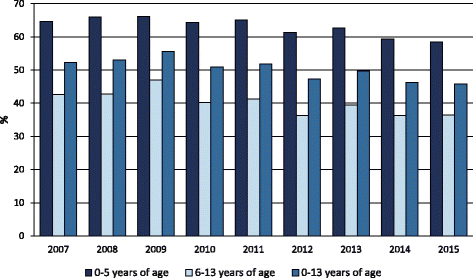
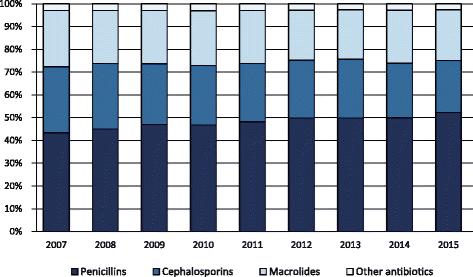
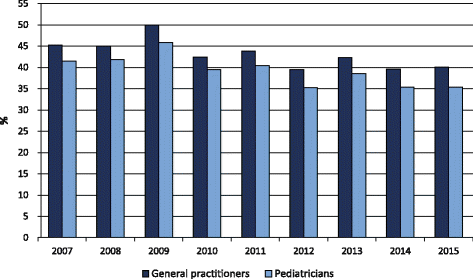
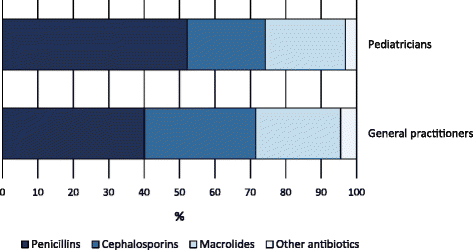
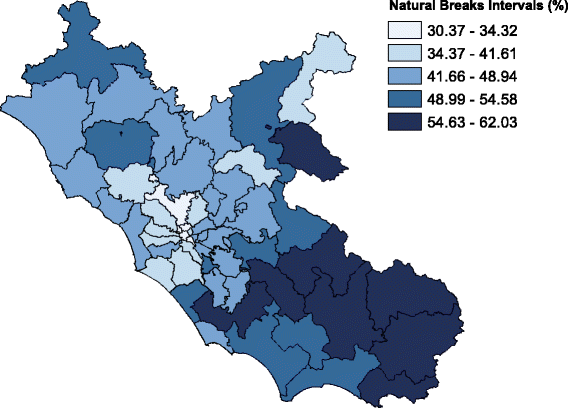
Similar articles
-
Antibiotic prescribing for pediatric respiratory infections: What explains a large variation among physicians?Can Fam Physician. 2019 Jun;65(6):e278-e291. Can Fam Physician. 2019. PMID: 31189642 Free PMC article.
-
Using Prescription Patterns in Primary Care to Derive New Quality Indicators for Childhood Community Antibiotic Prescribing.Pediatr Infect Dis J. 2016 Dec;35(12):1317-1323. doi: 10.1097/INF.0000000000001324. Pediatr Infect Dis J. 2016. PMID: 27626915
-
Improvement of antibiotic prescription in outpatient care: a cluster-randomized intervention study using a sentinel surveillance network of physicians.J Antimicrob Chemother. 2015 Feb;70(2):602-8. doi: 10.1093/jac/dku394. Epub 2014 Oct 17. J Antimicrob Chemother. 2015. PMID: 25326088 Clinical Trial.
-
[Antibiotic therapy in Bielefeld (AnTiB)-a local project for the promotion of rational antibiotic prescribing in the outpatient pediatric sector].Bundesgesundheitsblatt Gesundheitsforschung Gesundheitsschutz. 2019 Aug;62(8):952-959. doi: 10.1007/s00103-019-02978-y. Bundesgesundheitsblatt Gesundheitsforschung Gesundheitsschutz. 2019. PMID: 31209503 Review. German.
-
Differences in antibiotic prescribing in paediatric outpatients.Arch Dis Child. 2011 Jun;96(6):590-5. doi: 10.1136/adc.2010.183541. Epub 2011 Jan 12. Arch Dis Child. 2011. PMID: 21233078 Review.
Cited by
-
Epidemiology of Antibiotic Resistant Pathogens in Pediatric Urinary Tract Infections as a Tool to Develop a Prediction Model for Early Detection of Drug-Specific Resistance.Antibiotics (Basel). 2022 May 26;11(6):720. doi: 10.3390/antibiotics11060720. Antibiotics (Basel). 2022. PMID: 35740127 Free PMC article.
-
Implementation of a Multifaceted Program to Improve the Rational Use of Antibiotics in Children under 3 Years of Age in Primary Care.Antibiotics (Basel). 2024 Jun 21;13(7):572. doi: 10.3390/antibiotics13070572. Antibiotics (Basel). 2024. PMID: 39061254 Free PMC article.
-
Factors Associated with Geographical Variability of Antimicrobial Use in Japan.Infect Dis Ther. 2023 Dec;12(12):2745-2755. doi: 10.1007/s40121-023-00893-z. Epub 2023 Nov 29. Infect Dis Ther. 2023. PMID: 38019383 Free PMC article.
-
Usefulness of rapid molecular tests in pediatric respiratory tract infections.Ital J Pediatr. 2022 Feb 3;48(1):21. doi: 10.1186/s13052-022-01200-1. Ital J Pediatr. 2022. PMID: 35115016 Free PMC article.
-
Antibiotic prescription from qualified sources for children with fever/cough: cross-sectional study from 59 low- and middle-income countries.EClinicalMedicine. 2023 Jun 29;61:102055. doi: 10.1016/j.eclinm.2023.102055. eCollection 2023 Jul. EClinicalMedicine. 2023. PMID: 37434742 Free PMC article.
References
-
- Ciofi degli Atti ML, Massari M, Bella A, Boccia D, Filia A, Salmaso S, SPES study group Clinical, social and relational determinants of paediatric ambulatory drug prescriptions due to respiratory tract infections in Italy. Eur J Clin Pharmacol. 2006;62(12):1055–1064. doi: 10.1007/s00228-006-0198-8. - DOI - PubMed
MeSH terms
Substances
LinkOut - more resources
Full Text Sources
Other Literature Sources
Medical

